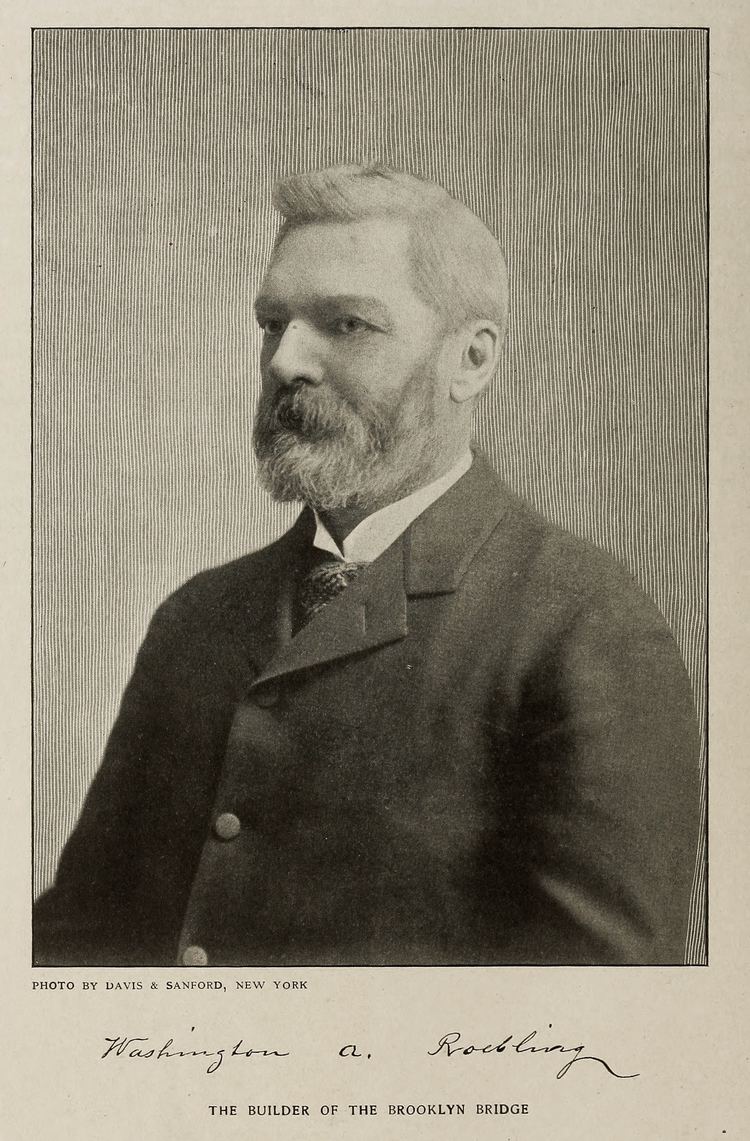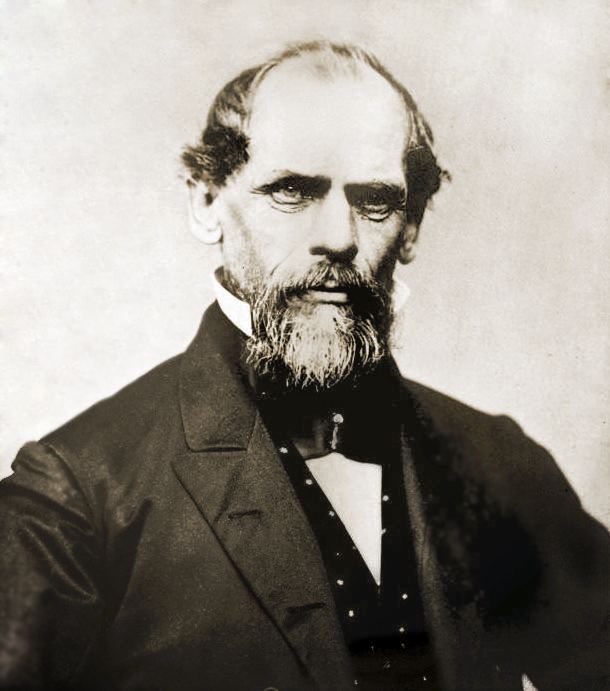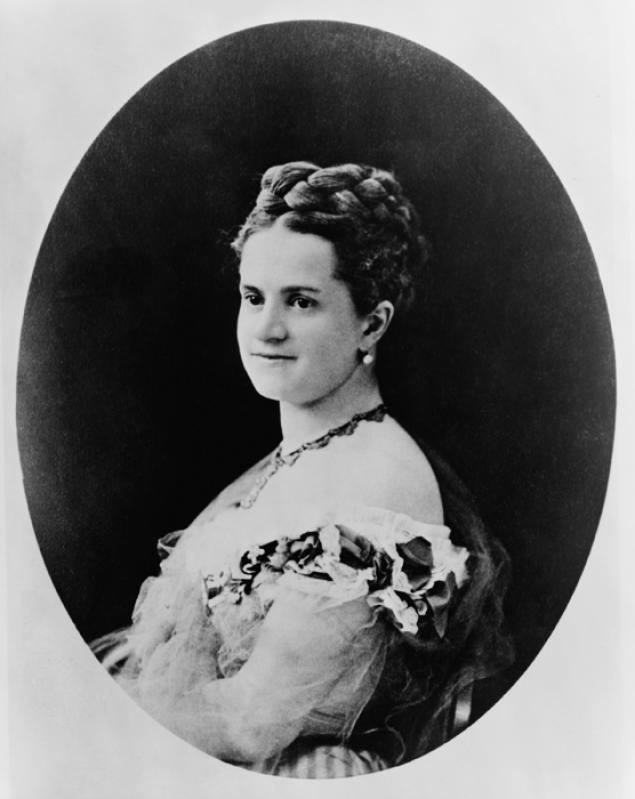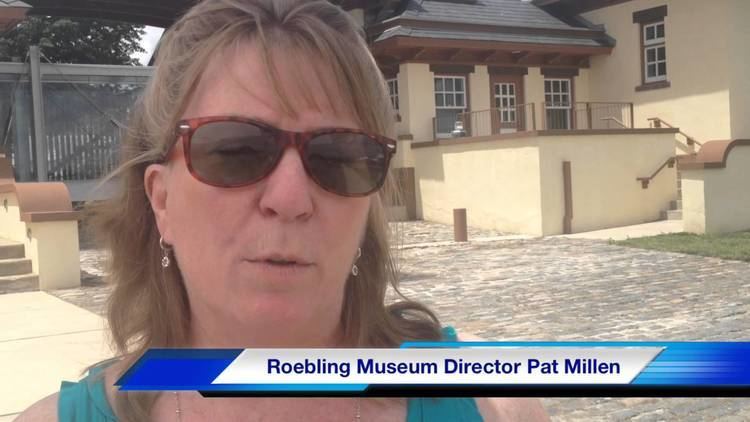Occupation Architect Name Washington Roebling | Role Civil engineer Parents John A. Roebling | |
 | ||
Full Name Washington Augustus Roebling Books Pneumatic Tower Foundations of the East River Suspension Bridge Structures Brooklyn Bridge, John A Roebling Suspensi, Wheeling Suspension Bridge Similar People John A Roebling, Emily Warren Roebling, Gouverneur K Warren, David B Steinman, Charles Ellet - Jr | ||
Washington roebling civil war engineer
Washington Augustus Roebling (May 26, 1837 – July 21, 1926) was an American civil engineer best known for supervising the construction of the Brooklyn Bridge, which was initially designed by his father John A. Roebling. He served in the Union Army during the American Civil War as an officer and was present at the Battle of Gettysburg.
Contents
- Washington roebling civil war engineer
- The Man Who Built the Brooklyn Bridge
- Education and military service
- Construction of the Brooklyn Bridge
- Later years
- References

The Man Who Built the Brooklyn Bridge
Education and military service

The oldest son of John Roebling, Washington was born in Saxonburg, Pennsylvania, a town co-founded by his father and his uncle, Carl Roebling. His early schooling consisted of tutoring by Riedel and under Henne in Pittsburgh. He was also sent to stay with Professor Lemuel Stephens of the Western University of Pennsylvania (now known as the University of Pittsburgh) where Roebling also attended some classes. He eventually attended the Trenton Academy and acquired further education at the Rensselaer Polytechnic Institute in Troy, New York, from 1854 to 1857, where he wrote a thesis titled "Design for a Suspension Aqueduct." Following his graduation as civil engineer (C.E.), he joined his father to work as a bridge builder. From 1858 to 1860, he assisted his father on the Allegheny Bridge project, living in a boarding house on Penn Street. Following the completion of the bridge, he returned to Trenton to work in his father's wire mill.

On April 16, 1861, during the American Civil War, Roebling enlisted as a private in the New Jersey Militia. Seeking more than garrison duty, he resigned after two months and re-enlisted in a New York artillery battery, 2nd Lieut. Company K, 83rd NY Volunteers performing staff duty engaged in the erection of suspension bridges. He rose steadily in rank and was soon commissioned as an officer.

Roebling saw action in numerous battles: Manassas Junction (Second Bull Run), Antietam, Chancellorsville, the Wilderness, Siege of Petersburg, and most notably Battle of Gettysburg. Soon after Chancellorsville, he was perhaps the first to note the movement of Robert E. Lee's Confederate Army toward the northwest while conducting air balloon reconnaissance.

On July 2, 1863, during Gettysburg, Roebling was one of the initial officers on Little Round Top. Observing signs of Confederate troops approaching, he hurried down the hill to report to Brig. Gen. Gouverneur K. Warren, for whom Roebling was aide-de-camp. General Warren and Roebling then descended the hill to find troops to secure this important tactical position. Roebling assisted in hoisting artillery up the hill, while Warren sent two of his aides, one of whom was Lt. Ranald S. Mackenzie, searching for infantry support. The two aides were able to secure a brigade from the Union V Corps. This brigade was commanded by Col. Strong Vincent whose brigade immediately occupied the hill and defended the left flank of the Army of the Potomac against repeated Confederate attacks. As Vincent's brigade began moving into position, Warren and Roebling had left the hill and Roebling was able to send the 140th New York Volunteers to the hill, not knowing that Vincent's brigade was already engaging advancing Confederate troops. However, the 140th New York provided much needed reinforcements.

Roebling was brevetted lieutenant colonel in December 1864 for gallant service, ending his service brevetted to colonel. After the war, he became a veteran companion of the Military Order of the Loyal Legion of the United States.
Construction of the Brooklyn Bridge

From mid-1865 to 1867, Roebling worked with his father on the Cincinnati-Covington Bridge (now the John A. Roebling Suspension Bridge). While traveling in Europe to research wire mills, bridges and caisson foundations, his only son, John A. Roebling, II, was born. After returning in 1868, Washington became assistant engineer on the Brooklyn Bridge, and was named chief engineer after his father's death in mid-1869. He made several important improvements on the bridge design and further developed bridge building techniques. Thus, he designed the two large pneumatic caissons that became the foundations for the two towers. In 1870, fire broke out in one of the caissons; from within the caisson, Roebling directed the efforts to extinguish the flames. Working in compressed air in these caissons under the river caused him to get decompression sickness ("the bends") shattering his health and rendering him unable to visit the site, yet he continued to oversee the Brooklyn project to successful completion in 1883. Besides the bends, he may have had additional afflictions, possible neurasthenia, side effects of treatments, and secondary drug addiction. His wife, Emily Warren Roebling, who had taken it upon herself to learn bridge construction, became his nurse, companion, and confidant and took over much of the chief engineer's duties including day-to-day supervision and project management. Although husband and wife jointly planned the bridge's continued construction, Emily successfully lobbied for formal retention of Washington as chief engineer. McCullough remarked that "nowhere in the history of great undertakings is there anything comparable" to Roebling conducting the largest and most difficult engineering project ever "in absentia."
Roebling would battle the after-effects from the caisson disease and its treatment the rest of his life.
Later years
Following the Brooklyn project, Roebling and his wife lived in Troy, New York, from 1884 to 1888, as their only child, John A. Roebling, II, also attended the Rensselaer Polytechnic Institute (RPI). When their son graduated, the Roeblings returned to Trenton, moving to 191 West State Street in 1892. From 1902 to 1903 Roebling served as President of the Alumni Association at Rensselaer. His wife Emily died in 1903 from stomach cancer. Roebling remarried in 1908 to Cornelia Witsell Farrow of Charleston, South Carolina.
His namesake (nephew), Washington Augustus Roebling II, born March 25, 1881, only son of his brother Charles G. Roebling, went down with the RMS Titanic in 1912.
Following the sudden death of another nephew, Karl Gustavus Roebling, in 1921, Roebling again became president of John A. Roebling's Sons Company at age 84. He died in 1926, after being bedridden for two months, at age 89.
Roebling's most passionate hobby was collecting rocks and minerals. His collection of over 16,000 specimens was donated by his son, John A. Roebling, II, to the Smithsonian Institution and became an important part of its mineral and gem collection.
Many of his manuscripts, photographs, and publications, can be found in the Roebling collections at Rutgers University in New Brunswick, New Jersey, and at Rensselaer Polytechnic Institute in Troy, New York.
